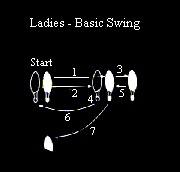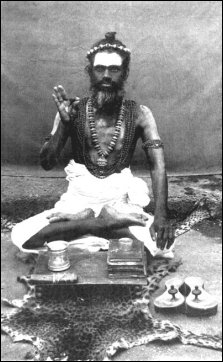


|
The piano has been drinking my necktie is asleep and the combo went back to New York the juke box has to take a leak and the carpet needs a haircut and the spot light looks like a prison break cause the telephone is out of cigarettes and the balconey's on the make and the piano has been drinking the piano has been drinking
and the menus are all freezing
cause the bouncer is a Sumo wrestler
and you can't find your waitress
Tom Waits
|

Reading Record Grooves
The man in question, Dr. Arthur Lintgen of Pennsylvania, said he could look at a record of fully orchestrated post-Mozart classical music and identify the composer, often the piece, and sometimes even the performing artist. Randi subjected him to his usual rigorous tests and discovered that he was telling the exact truth. The physician correctly identified two different recordings of Stravinsky's Rite of Spring , as well as Ravel's Bolero , Holst's The Planets , and Beethoven's Sixth Symphony.
Naturally Randi showed him some other records as controls. One, labeled "gibberish" by Dr. Lintgen, was Alice Cooper. On seeing another control, he said, "This is not instrumental music at all. I'd guess that it's a vocal solo of some kind." In fact it was a recording of a man speaking, titled So You Want to Be a Magician.
This odd claim that turned out to be genuine violated no important principle. The necessary information was whether someone had really been able to abstract that information by inspection. Randi confirmed that indeed someone had.
Murray Gell-Mann
|
Please accept our Personal Invitation for you to come to the famous
Hare Krishna
and enjoy pure vegatarian
Every Sunday
at your local |

|
How to chant
There are two basic types of chanting. Personal meditation, where one chants alone on beads, is called japa. When one chants in responsive fashion with others, this is called kirtana. Kirtana is usually accompanied by musical instruments and clapping. Both forms of chanting are recommended and beneficial.
To perform the first type of meditation, one needs only a set of japa beads. These may be purchased from any Hare Krishna temple or, if you like, you can make your own beads at home.
If you decide to make your japa beads, follow these simple instructions :
1. Buy 109 large round beads and some strong, thick nylon thread.
2. Tie a knot about six inches from the end of a long piece of the thread and then string the beads, tying a knot after each one.
3. After stringing 108 beads, pull the two ends of thread through one large master bead.
4. This bead is called the Krishna bead. Tie a knot next to it and cut off the excess thread. You now have your own set of japa beads.
To meditate with the beads, hold them in your right hand. Hold the first bead with your thumb and middle finger and chant the complete
maha-mantra-
Hare Krishna, Hare Krishna, Krishna Krishna, Hare Hare, Hare Rama, Hare Rama, Rama Rama, Hare Hare. Then go to the next bead, holding it with the same two fingers, again chanting the entire
mantra. Then go on to the next bead and then the next, continuing in this way until you have chanted on all 108 beads and have come to the Krishna bead. You have now completed one "round" of chanting. Do not chant on the Krishna bead, but turn the beads around and chant on them in the opposite direction, one after another.
Chanting on beads is especially helpful, for it engages the sense of touch in the meditative process and helps you concentrate even more on the sound of the mantra.


'Mudskippers,' said Mark, who happened along at the moment. He squatted down to look at them.
'What are they doing in the tree?' I asked.
'You could say they were experimenting,' said Mark. 'If they find they can make a better living on the land than in the water, then in the course of time and evolution they may come to stay on the land. They absorb a certain amount of oxygen through their skin at the moment, but they have to rush back to the sea from time to time for a mouthful of water which they process through their gills. But that can change. It's happened before.'
'What do you mean?'
'Well, it's probable that life on this planet started in the oceans, and that marine creatures migrated on to the land in search of new habitats. There's one fish that existed about 350 million years ago which was very like a mudskipper. It came up on to the land using its fins as crutches. It's possible that it was the ancestor of all land-living vertebrates.'
'Really? What was it called?'
'I don't think it had a name at the time.'
'So this fish is what we were like 350 million years ago?'
'Quite possible.'
'So in 350 million years time one of its descendants could be sitting on the beach here with a camera round its neck watching other fish hopping out of the sea?'
'No idea. That's for science fiction novelists to think about. Zoologists can only say what we think has happened so far.'
I suddenly felt, well, terribly old as I watched a mudskipper hopping along with what now seemed to me like a wonderful sense of hopeless, boundless, naive optimism. It had such a terribly, terribly, terribly long way to go. I hoped that if its descendant was sitting here on this beach on 350 million years time with a camera round its neck, it would feel that the journey had been worth it. I hoped that it might have a clearer understanding of itself in relation to the world it lived in. I hoped that it wouln't be reduced to turning other creatures into horror circus shows in order to try and ensure them their survival. I hoped that if someone tried to feed the remote descendant of a goat to the remote descendant of a dragon for the sake of a little more than a shudder of entertainment, that it would feel it was wrong.
I hoped it wouln't be too chicken to say so.

|
Homing things
For years Mrs M. Coyle of Glasgow carried a lucky sixpence in her purse. But in 1971, the day before she went on holiday, she accidentally spent it. This upset her, but she need not have worried. Two days later she received the same coin back, clearly marked with her initials, in change given to her in a small village in Northern Ireland. Colin Hill went on holiday to Torquay in Devon in 1976, arriving at the harbour just as skin divers surfaced with a pair of spectacles he had lost there on his last visit seven years earlier. The harbour master of Newport in Monmouthshire took his bride to Dawlish in Devon for their honeymoon. The only sad moment of their week's holiday was her loss of a treasured gold bracelet while bathing in the sea. Twenty-eight years later they went back for a second honeymoon and, while sitting in deck chairs watching the tide go out, noticed a glint of gold at the water's edge. They went together to investigate - and discovered that it was the very same bracelet. John Cross of Newport News in Virginia lost a ring while crossing Hampton Roads during a storm in 1980. Two years later it turned up inside a fish served at his favourite restaurant in Charlottesville. Lyall Watson |








